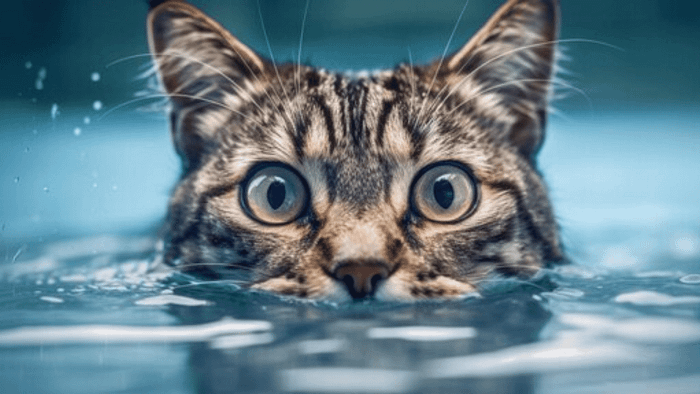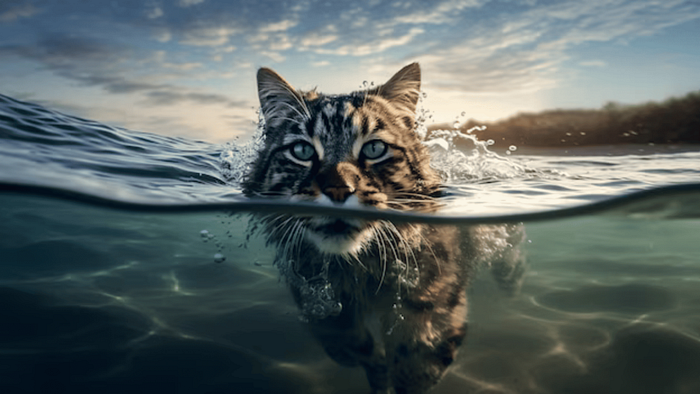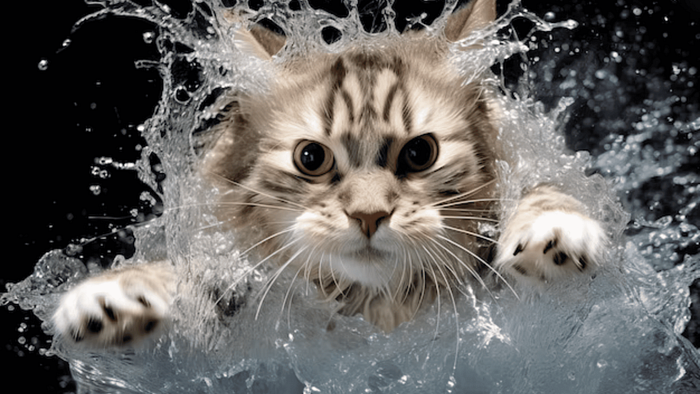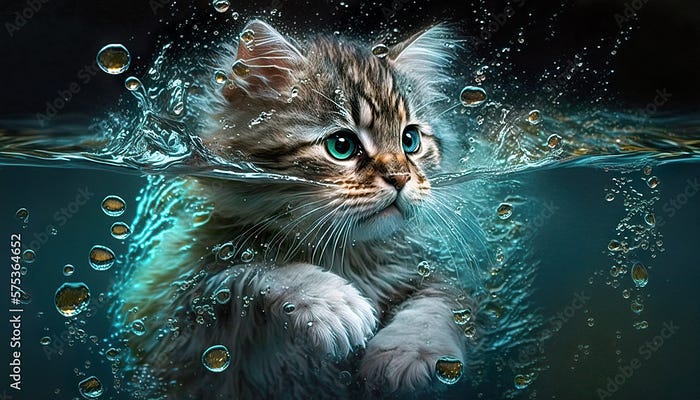Does My Cat Swimming Like? How to Know?

Does My Cat Swimming Like? How to Know?
2 March 2024 by whitepersiancat.com
Cat Swimming: Many perceive cats as creatures with an innate aversion to water, often associating them with images of frantic escapes from bathtubs. However, the relationship between cats and water is more nuanced than commonly believed. In this article, we explore the truth behind cats and swimming, dispelling myths and uncovering the facts.
Table of Contents
- Do Cats Know How to Swim? (Cat Swimming)
- Do Cats Enjoy Swimming?
- Introducing Cats to Water (Cat Swimming)
- Exploring Cats’ Relationship with Water
- Factors Influencing Cats’ Attitude Towards Water
- Practical Tips for Water Safety with Cats
- Embracing Cats’ Unique Preferences
- Tailoring Activities to Your Cat’s Preferences (Cat Swimming).
- Conclusion
- FAQs
- Can all cats swim?
- Are there cat breeds that love water?
- How can I introduce my cat to water?
- Is it safe to take my cat swimming?
- What should I do if my cat dislikes water?
Do Cats Know How to Swim? (Cat Swimming)
Contrary to popular belief, cats possess innate swimming abilities ingrained in their evolutionary history. While the domestication of cats may have shifted their lifestyles, their ancestral instincts remain intact. Historically, cats roamed diverse landscapes, encountering water bodies necessitating swimming for survival. These experiences led to the development of natural swimming skills, ensuring their adaptability to various environments. (Cat Swimming).
Even modern-day domestic cats retain these instincts, though individual swimming prowess varies. Factors such as age, health, and prior exposure influence a cat’s swimming capabilities. While every cat can paddle to stay afloat momentarily, sustained swimming demands significant physical exertion, posing drowning risks under unfavorable conditions.

Do Cats Enjoy Swimming?
The notion of cats universally disliking water overlooks exceptions observed in specific breeds. While many cats exhibit aversion to water due to practical concerns like wet fur and discomfort, certain breeds, such as the Bengal and Turkish Van, display a remarkable affinity for aquatic activities. These outliers embrace water as a source of recreation, engaging in playful swimming ventures akin to their wild counterparts. (Cat Swimming).
Understanding individual cat preferences is crucial in gauging their enjoyment of swimming. While some may relish water-based adventures, others may exhibit apprehension. Regardless of breed predispositions, fostering a positive association with water requires patience and gentle encouragement. (Cat Swimming)
Introducing Cats to Water (Cat Swimming)
For cat owners envisioning aquatic escapades with their feline companions, gradual introduction is key. Coaxing cats towards water using positive reinforcement facilitates familiarity and reduces reluctance. Avoiding forceful methods preserves trust and allows cats to acclimate at their pace, fostering a genuine fondness for water activities.
Prioritizing safety is paramount during cat-water interactions. Implementing precautionary measures, such as securing pool areas and utilizing pet life vests, mitigates potential risks. Additionally, respecting a cat’s boundaries and monitoring their comfort levels ensures enjoyable experiences for both cat and owner.

Exploring Cats’ Relationship with Water
Contrary to the common stereotype of cats being averse to water, there are exceptions to this belief. While some cats may shy away from water, others exhibit a surprising affinity for it. This diversity in behavior begs the question: what factors influence a cat’s attitude towards water?
Factors Influencing Cats’ Attitude Towards Water
- Genetics: Breed predisposition plays a significant role in determining a cat’s relationship with water. Certain breeds, such as the Turkish Van and Maine Coon, have been historically associated with a fondness for water-related activities. These breeds often possess physical traits, such as water-resistant coats and webbed feet, that facilitate swimming and increase comfort in aquatic environments. (Cat Swimming)
- Early Experiences: A cat’s early encounters with water can shape its future attitude towards it. Cats exposed to water in a positive, non-threatening manner during kittenhood are more likely to develop a favorable perception of water. Conversely, traumatic experiences or negative associations with water can instill fear or aversion in cats, influencing their behavior in adulthood.
- Environmental Factors: The environment in which a cat is raised can impact its relationship with water. Cats living in coastal regions or households with access to bodies of water may have more opportunities for exposure to water, potentially fostering a greater comfort level with aquatic environments. Conversely, cats raised in landlocked areas or urban settings may have limited exposure to water, leading to a lack of familiarity and potential apprehension. (Cat Swimming)
- Individual Personality: Like humans, cats exhibit individual personalities and preferences. Some cats may possess a natural curiosity and adventurous spirit that drives them to explore water, while others may prefer to observe from a safe distance. Understanding and respecting each cat’s unique temperament is essential in nurturing a positive relationship with water.
Practical Tips for Water Safety with Cats
- Supervision: Always supervise your cat during water-related activities, especially if they are inexperienced swimmers or exhibit apprehension towards water. Vigilance is key to ensuring their safety and preventing accidents.Cat Swimming).
- Training and Conditioning: Gradually introduce your cat to water in a controlled environment, using positive reinforcement techniques such as treats and praise to encourage confidence and familiarity. Start with shallow water and allow your cat to acclimate at their own pace.
- Water Safety Equipment: Consider investing in water safety equipment such as pet life vests, particularly if you plan to engage in water-based activities with your cat, such as boating or kayaking. These vests provide an extra layer of protection and buoyancy, reducing the risk of accidents.
- Drying and Grooming: After water activities, ensure thorough drying and grooming to prevent discomfort and potential health issues such as skin infections. Pay special attention to drying sensitive areas such as ears and paw pads.
- Respecting Boundaries: Respect your cat’s boundaries and cues during water-related interactions. If your cat exhibits signs of distress or discomfort, such as vocalization or attempts to escape, immediately remove them from the water and provide reassurance in a calm, supportive manner.
By understanding the factors influencing cats’ attitudes towards water and implementing practical safety measures, cat owners can foster a safe and enriching environment for water-based activities. Whether your feline companion is a water enthusiast or prefers to keep their paws dry, respecting their individual preferences and ensuring their well-being is paramount.
Embracing Cats’ Unique Preferences
Cats, like humans, have their own individual preferences and personalities. While some may revel in the opportunity to explore aquatic environments, others may prefer to remain firmly on dry land. As responsible pet owners, it’s essential to respect and accommodate these differences, ensuring that our feline companions feel safe and secure in their surroundings. (Cat Swimming).

Tailoring Activities to Your Cat’s Preferences (Cat Swimming).
- Indoor Enrichment: For cats who prefer to stay dry, there are plenty of indoor activities that can provide mental and physical stimulation. Interactive toys, puzzle feeders, and vertical spaces for climbing and perching can help fulfill their natural instincts and keep them entertained.
- Outdoor Adventures: If your cat enjoys the great outdoors but is wary of water, consider outdoor adventures that don’t involve swimming. Harness training allows cats to explore safely under supervision, while enclosed outdoor spaces, such as catio enclosures or cat-proof gardens, provide opportunities for fresh air and sensory stimulation.
- Alternative Water Activities: Not all water-related activities require swimming. Some cats may enjoy gentle water play, such as pawing at a shallow basin of water or chasing floating toys in a controlled environment. These activities can be a fun way to engage your cat’s natural curiosity without the need for full immersion.
- Bonding Time: Regardless of their affinity for water, spending quality time with your cat is essential for building trust and strengthening your bond. Engage in activities that your cat enjoys, whether it’s playing with toys, grooming sessions, or simply lounging together in a cozy spot.
Also Read: Unbiased Royal Canin Persian Cat Food Review 2024
Also Read: Embracing Elegance: Persian Cat for Sale 3000 in Srinagar
Conclusion
Cat Swimming: The relationship between cats and swimming extends beyond stereotypes, encompassing a spectrum of behaviors influenced by genetics, upbringing, and individual temperament. While not all cats embrace aquatic pursuits, understanding their inherent capabilities and preferences empowers owners to facilitate enriching experiences tailored to their feline companions.
FAQs
Can all cats swim?
While all cats possess basic swimming instincts, individual proficiency varies.
Are there cat breeds that love water?
Yes, breeds like the Bengal and Turkish Van are known for their affinity for water.
How can I introduce my cat to water?
Gradual exposure, positive reinforcement, and patience are essential in acclimating cats to water.
Is it safe to take my cat swimming?
Prioritize safety by implementing precautions and monitoring your cat’s comfort and behavior.
What should I do if my cat dislikes water?
Respect your cat’s preferences and avoid forcing them into water-related activities.
